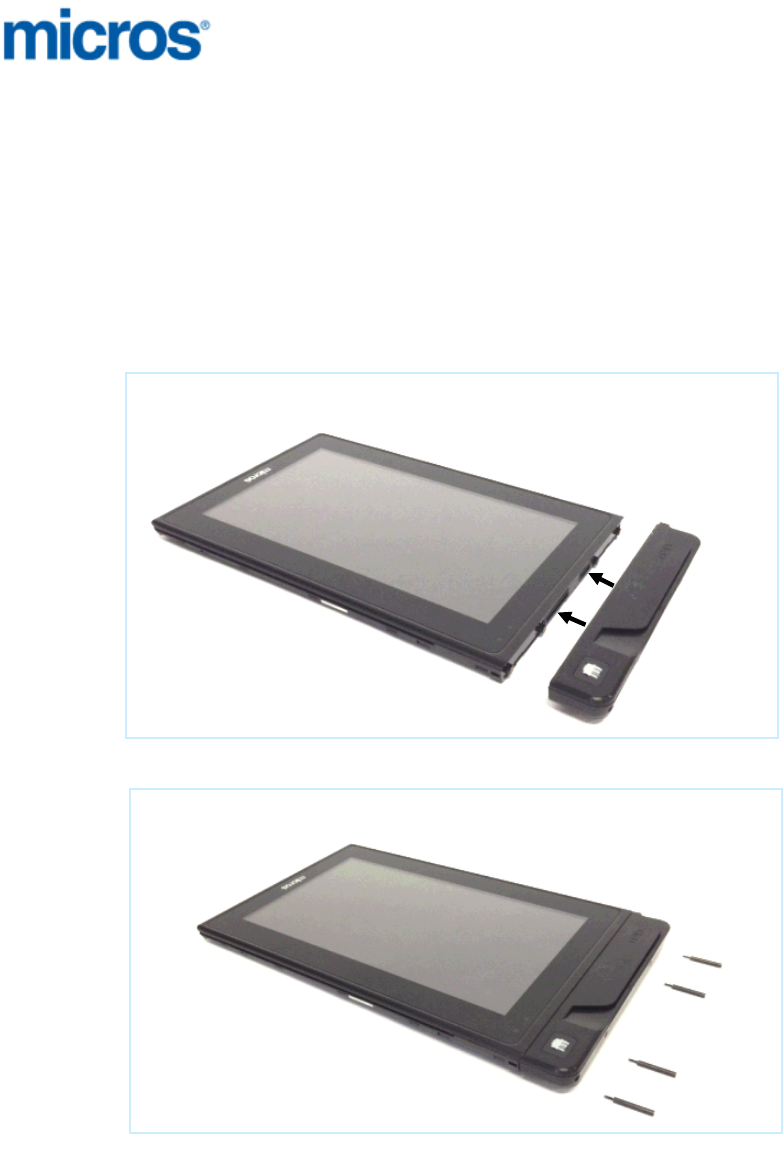Oracle America ENDCAP mTablet RFID/ Imager Module User Manual User Guide
MICROS SYSTEMS, INC mTablet RFID/ Imager Module User Guide
User Guide

Page1of6
Installing the mTablet RFID/Imager Module
The following procedure describes how to install the mTablet RFID/Imager Module to MICROS
mTablet.
1. Place the mTablet on table.
2. Gently attach the mTablet RFID/Imager Module as shown in figure1.
3. Find the screw holes at mTablet RFID/Imager Module, as figure 2
4. Lastly, place the screws and tighten it with alien key.
mTablet mTablet RFID
/Imager Module
Fi
g
ure 1
Fi
g
ure
2

Page2of6
Product Information
The mTablet RFID/Imager Module have three main functions:
• MSR
• Scanner
• NFC function
MSRslot
Scannerwindow
ScannerPressButton
NFC(RFID)taparea

Page3of6
Specification
Specification Parameter
Model mTablet RFID/ Imager Module
Rating 3.3 VDC, 50mA (for MSR function)
5VDC, 550mA (for Scanner and NFC function)
Weight About 150g
Overall Dimension 170mm x 30mm x20.5 mm
Storage Temperature -20 to 70 degree Celsius
Operating Temperature -10 to 50 degree Celsius
Operating Humidity
Operating: 95% RH (no condensation) at 50 degree
Celsius
Storage: 85% RH, non-condensing at 70 degree Celsius
Enclosure Material Plastic
Scanner Technical
Specification
Imaging Sensor
Resolution: 752 H x 480 V
pixels (Wide VGA)
Gray Scale: 256 levels (8bits
per pixel)
Ambient light immunity
(Sunlight) 9000 ft. candles (96,900 lux)
Laser Safety Class CDRH / IEC Class 2
NFC Function Frequency 13.56MHz
FCC ID A4HENDCAP
Canada IC ID 9870A-ENDCAP
MSR Function 3.3V powered, magnetic card reader

Page4of6
Safety Information
SCANNER ENGINE
:ThisdeviceemitsCDRH/IECClass2laser.Donotstareintobeam.

Page5of6
EMC RF Information
This device complies with Part 15 of the FCC Rules / Industry Canada licence-exempt RSS
standard(s). Operation is subject to the following two conditions: (1) this device may not cause
harmful interference, and (2) this device must accept any interference received, including
interference that may cause undesired operation.
Le présent appareil est conforme aux CNR d'Industrie Canada applicables aux appareils radio
exempts de licence. L'exploitation est autorisée aux deux conditions suivantes : (1) l'appareil ne
doit pas produire de brouillage, et (2) l'utilisateur de l'appareil doit accepter tout brouillage
radioélectrique subi, même si le brouillage est susceptible d'en compromettre le fonctionnement.
Changes or modifications not expressly approved by the party responsible for compliance could
void the user's authority to operate the equipment.
This equipment has been tested and found to comply with the limits for a Class B digital device,
pursuant to part 15 of the FCC Rules. These limits are designed to provide reasonable
protection against harmful interference in a residential installation. This equipment generates
uses and can radiate radio frequency energy and, if not installed and used in accordance with
the instructions, may cause harmful interference to radio communications. However, there is no
guarantee that interference will not occur in a particular installation. If this equipment does
cause harmful interference to radio or television reception, which can be determined by turning
the equipment off and on, the user is encouraged to try to correct the interference by one or
more of the following measures:
—Reorient or relocate the receiving antenna.
—Increase the separation between the equipment and receiver.
—Connect the equipment into an outlet on a circuit different from that to which the receiver is
connected.
—Consult the dealer or an experienced radio/TV technician for help.
Under Industry Canada regulations, this radio transmitter may only operate using an antenna of
a type and maximum (or lesser) gain approved for the transmitter by Industry Canada. To
reduce potential radio interference to other users, the antenna type and its gain should be so
chosen that the equivalent isotropically radiated power (e.i.r.p.) is not more than that necessary
for successful communication.

Page6of6
Conformément à la réglementation d'Industrie Canada, le présent émetteur radio peut
fonctionner avec une antenne d'un type et d'un gain maximal (ou inférieur) approuvé pour
l'émetteur par Industrie Canada. Dans le but de réduire les risques de brouillage radioélectrique
à l'intention des autres utilisateurs, il faut choisir le type d'antenne et son gain de sorte que la
puissance isotrope rayonnée équivalente (p.i.r.e.) ne dépasse pas l'intensité nécessaire à
l'établissement d'une communication satisfaisante.